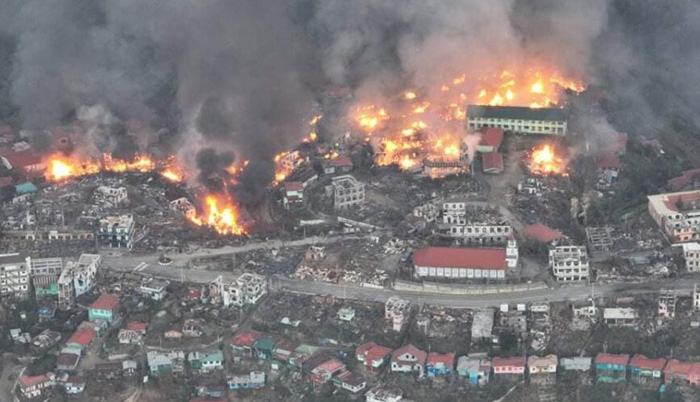![]() Home > Myanmar
Home > Myanmar
Why Myanmar Junta’s ‘Four Cuts’ Arson Strategy Is Failing To Quell Resistance

Houses in Thantlang town, Chin State, burn during a series of arson attacks by regime forces in February. Photo- The Chinland Post
![]() October 22nd, 2022 | 11:55 AM |
October 22nd, 2022 | 11:55 AM | ![]() 438 views
438 views
MYANMAR
In a return to its infamous “four cuts” strategy, the Myanmar military is launching near-daily arson attacks on civilian houses to weaken the national anti-regime movement in its strongholds.
The past two weeks has seen regime forces torch houses in at least 20 villages in Sagaing and Magwe regions, the country’s hub of armed resistance.
Several-hundred houses were burned and several-thousand residents forced back into homelessness by the latest round of junta arson attacks.
The Myanmar military’s “Four Cuts” policy was developed in the 1970s during the former regime of the Burmese Socialist Programme Party. The aim was to undermine ethnic militias by cutting their access to food, funds, information and recruits – a policy that often had devastating consequences.
Now the regime has partially returned to its old strategy, hoping that repeated raids and arson attacks on villages in areas of rebellion will deter locals from supporting resistance fighters and sever their four lifelines.
The junta launched its first arson attack following the Feb. 2021 coup in Pauk Township, Magwe Region, on June 15 last year. Regime troops burned almost all of the 240 houses in In Ma Village in retaliation for an ambush by local resistance forces nearby.
After the mass-arson attack drew strong condemnation from the domestic and international community, the military regime loudly claimed its forces were not responsible, amid strong evidence and eyewitnesses attesting to the contrary.
Junta forces escalated their campaign of arson, arbitrary and extrajudicial killings, indiscriminate shelling and airstrikes on both resistance forces and civilian targets in September last year, when Myanmar’s parallel National Unity Government declared a war of resistance against the junta.
Regime forces perpetrating the raids and arson attacks routinely loot valuables including gold, cashes, furniture, and electronic devices as well as killing livestock for food. They also burn other property including food, rice, seeds, agricultural machinery and vehicles used by locals to make their living.
As of August 25 this year, an estimated 28,434 civilian houses and religious buildings had been destroyed by junta arson attacks across the country, according to Data for Myanmar, an independent research group documenting the regime’s destruction of civilian property.
However, the research group believes the actual number of houses burned down by junta soldiers is far higher, since it has been unable to verify many other arson attacks.
The worst damage has been done in Sagaing Region, a resistance hub where around 20,153 houses have been torched by junta forces. Of the 37 townships in Sagaing, 31 have reported regime arson attacks and destruction.
Neighboring Magwe Region, another resistance stronghold, has lost around 5,418 properties to junta arson attacks.
Third-worst hit is neighboring Chin State, with 1,474 houses torched by regime troops.
The Chin town of Thanglang was reduced to ashes after regime forces burned almost all of its 1,300 houses and religious buildings in repeated attacks between September 2021 and June 2022.
The junta responded to the growing number of resistance attacks by escalating its arson campaign from April to June this year, destroying a total of 15,000 houses in just three months.
By September 26, an estimated 1,017,000 people across the country had been displaced by conflict and violence since the military coup last year, according to the United Nations children’s fund (Unicef).
More than half of those displaced are from Sagaing Region, where 545,200 people have fled, Unicef reported.
Systematic attacks directed against any civilian population constitute a crime against humanity, according to international law.
More than one year after it began, we might ask whether the regime’s arson campaign has achieved its objective of cutting access to food, funds, information and recruits.
Given the unrelenting, near-daily attacks on regime targets and mushrooming of resistance forces in Sagaing and Magwe regions, the answer is a resounding no. On the contrary, the attacks appear to have united civilian populations and made them more determined to fight the regime.
The more civilian houses the junta destroys, the more people revolt, a Sagaing resistance told The Irrawaddy. People who have lost everything have joined the resistance, he added.
Source:
courtesy of THE IRRAWADDY
by NAYT THIT
If you have any stories or news that you would like to share with the global online community, please feel free to share it with us by contacting us directly at [email protected]